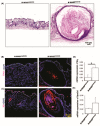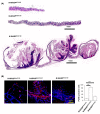Conditional Knockout of N-WASP Enhanced the Formation of Keratinizing Squamous Cell Carcinoma Induced by KRasG12D
- PMID: 37760426
- PMCID: PMC10526518
- DOI: 10.3390/cancers15184455
Conditional Knockout of N-WASP Enhanced the Formation of Keratinizing Squamous Cell Carcinoma Induced by KRasG12D
Abstract
Squamous cell carcinoma (SCC) is one of the most common forms of skin cancer in humans, and Neural Wiskott-Aldrich Syndrome Protein (N-WASP) plays a crucial role in epidermal homeostasis. To elucidate the role of N-WASP in skin cancer, we generated mice which expressed constitutively active KRas (KRasG12D) in keratinocytes with either homozygous (N-WASPKOG12D) or heterozygous (N-WASPHetG12D) N-WASP knockout upon Tamoxifen (TAM) injection. Both the N-WASPKOG12D and N-WASPHetG12D mice had similar body weights and no congenital malformations prior to the injection of TAM. Within 2 weeks of the injections, the N-WASPKOG12D mice exhibited significant reductions in weight coupled with visible tumors at numerous sites, unlike the N-WASPHetG12D mice, which had no visible tumors. We found that both sets of mice had oily, sticky skin and wet eyes 3 weeks after their exposure to TAM, indicating the overproduction of sebum/meibum. At 37 days post TAM injection, several notable observations were made. Tumors collected from the N-WASPKOG12D mice had small- to large-sized keratin pearls that were not observed in the N-WASPHetG12D mice. A Western blot and immunostaining analysis both highlighted significantly higher levels of expression of SCC markers, such as the cytokeratins 8, 17, 18, and 19 and TP63, in the tumors of the N-WASPKOG12D mice compared to those of the latter group. Furthermore, we noted increases in the expression levels of EGFR, P-ERK, GLUT1, P-mTOR, and P-4EBP in the N-WASPKOG12D mice, suggesting that the deletion of N-WASP in the keratinocytes enhanced KRas signaling and glucose uptake, resulting in aggressive tumor formation. Interestingly, a thickening of the epidermal layer within the esophagus and tongue was only observed in the N-WASPKOG12D mice. Immunostaining for PCNA emphasized a significantly higher number of PCNA-positive cells in the skin of the N-WASPKOG12D mice compared to their counterparts, implying that epidermal thickening and enhanced tumorigenesis are due to an increased proliferation of keratinocytes. Through our results, we have established that N-WASP plays a tumor-suppressive role in skin cancer.
Keywords: N-WASP; keratin pearl; skin cancer.
Conflict of interest statement
The authors declare no conflict of interest.
Figures






Similar articles
-
Conditional knock out of N-WASP in keratinocytes causes skin barrier defects and atopic dermatitis-like inflammation.Sci Rep. 2017 Aug 4;7(1):7311. doi: 10.1038/s41598-017-07125-8. Sci Rep. 2017. PMID: 28779153 Free PMC article.
-
Conditional knockout of N-WASP in mouse fibroblast caused keratinocyte hyper proliferation and enhanced wound closure.Sci Rep. 2016 Dec 2;6:38109. doi: 10.1038/srep38109. Sci Rep. 2016. PMID: 27909303 Free PMC article.
-
Oncogenic KRas-induced Increase in Fluid-phase Endocytosis is Dependent on N-WASP and is Required for the Formation of Pancreatic Preneoplastic Lesions.EBioMedicine. 2017 Feb;15:90-99. doi: 10.1016/j.ebiom.2016.12.013. Epub 2016 Dec 24. EBioMedicine. 2017. PMID: 28057438 Free PMC article.
-
The role of WASp in T cells and B cells.Cell Immunol. 2019 Jul;341:103919. doi: 10.1016/j.cellimm.2019.04.007. Epub 2019 Apr 17. Cell Immunol. 2019. PMID: 31047647 Review.
-
The Wiskott-Aldrich syndrome protein (WASP): roles in signaling and cytoskeletal organization.Annu Rev Immunol. 1999;17:905-29. doi: 10.1146/annurev.immunol.17.1.905. Annu Rev Immunol. 1999. PMID: 10358777 Review.
Cited by
-
A study on the global burden of non-melanoma skin cancer from 1990 to 2019.Arch Med Sci. 2024 Apr 14;20(6):1902-1908. doi: 10.5114/aoms/187003. eCollection 2024. Arch Med Sci. 2024. PMID: 39967956 Free PMC article.
-
Exposed Necrotic Bone in a Head and Neck Cancer Patient: Report of a Diagnostic Challenge.Diagnostics (Basel). 2025 Apr 9;15(8):952. doi: 10.3390/diagnostics15080952. Diagnostics (Basel). 2025. PMID: 40310399 Free PMC article.
References
-
- Schonberg B., Hunziker T., Braathen L.R. [Squamous epithelial cancer of the skin] Ther. Umsch. 1993;50:817–821. - PubMed
LinkOut - more resources
Full Text Sources
Molecular Biology Databases
Research Materials
Miscellaneous

